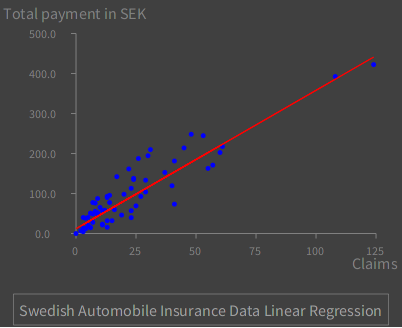DataFrame and Simple Linear Regression
In the previous post I mentioned using Iceberg successfully. The code I was pushing is SLRCalculator, a simple linear regression calculator, written to take Oleksandr Zaytsev's DataFrame library for a spin, by way of porting Jason Brownlee's excellent simple linear regression in Python to Pharo.
Firstly, install DataFrame. This also pulls in Roassal.
Metacello new
baseline: 'DataFrame';
repository: 'github://PolyMathOrg/DataFrame';
load.
SLRCalculator implements mean, variance, covariance, coefficients etc, and also incorporates the Swedish automobile insurance dataset used by Jason in his Python example.
SLRCalculator class>>loadSwedishAutoInsuranceData
"Source: https://www.math.muni.cz/~kolacek/docs/frvs/M7222/data/AutoInsurSweden.txt"
| df |
df := DataFrame fromRows: #(
( 108 392.5 )
( 19 46.2 )
( 13 15.7 )
"more lines" ).
df columnNames: #(X Y).
^ df
The computation for covariance also uses DataFrame.
covariance: dataFrame
| xvalues yvalues xmean ymean covar |
xvalues := dataFrame columnAt: 1.
yvalues := dataFrame columnAt: 2.
xmean := self mean: xvalues.
ymean := self mean: yvalues.
covar := 0.
1 to: xvalues size do: [ :idx |
covar := covar + (((xvalues at: idx) - xmean) * ((yvalues at: idx) - ymean)) ].
^ covar
Let's see how to use SLRCalculator to perform linear regression, with graphing using Roassal. First declare the variables and instantiate some objects:
| allData splitArray trainingData testData s coeff g dsa dlr legend |
s := SLRCalculator new.
allData := SLRCalculator loadSwedishAutoInsuranceData.
Next, split the data set into training and test subsets. Splitting without shuffling means to always take the first 60% of the data for training.
splitArray := s extractForTesting: allData by: 60 percent shuffled: false.
trainingData := splitArray at: 1.
testData := splitArray at: 2.
coeff := s coefficients: trainingData.
Set up for graphing. Load `allData' as points.
g := RTGrapher new.
allData do: [ :row |
dsa := RTData new.
dsa dotShape color: Color blue.
dsa points: { (row at: 1) @ (row at: 2) }.
dsa x: #x.
dsa y: #y.
g add: dsa ].
Create the points to plot the linear regression of the full data set, using the coefficients computed from the training subset.
dlr := RTData new.
dlr noDot.
dlr connectColor: Color red.
dlr points: (allData column: #X).
" y = b0 + (b1 * x) "
dlr x: #yourself.
dlr y: [ :v | (coeff at: 1) + (v * (coeff at: 2)) ].
g add: dlr.
Make the plot look nice.
g axisX noDecimal; title: 'Claims'.
g axisY title: 'Total payment in SEK'.
g shouldUseNiceLabels: true.
g build.
legend := RTLegendBuilder new.
legend view: g view.
legend addText: 'Swedish Automobile Insurance Data Linear Regression'.
legend build.
g view
Putting the code altogether:
| allData splitArray trainingData testData s coeff g dsa dlr legend |
s := SLRCalculator new.
allData := SLRCalculator loadSwedishAutoInsuranceData.
splitArray := s extractForTesting: allData by: 60 percent shuffled: false.
trainingData := splitArray at: 1.
testData := splitArray at: 2.
coeff := s coefficients: trainingData.
g := RTGrapher new.
allData do: [ :row |
dsa := RTData new.
dsa dotShape color: Color blue.
dsa points: { (row at: 1) @ (row at: 2) }.
dsa x: #x.
dsa y: #y.
g add: dsa ].
dlr := RTData new.
dlr noDot.
dlr connectColor: Color red.
dlr points: (allData column: #X).
" y = b0 + (b1 * x) "
dlr x: #yourself.
dlr y: [ :v | (coeff at: 1) + (v * (coeff at: 2)) ].
g add: dlr.
g axisX noDecimal; title: 'Claims'.
g axisY title: 'Total payment in SEK'.
g shouldUseNiceLabels: true.
g build.
legend := RTLegendBuilder new.
legend view: g view.
legend addText: 'Swedish Automobile Insurance Data Linear Regression'.
legend build.
g view
Copy/paste the code into a playground, press shift-ctrl-g...

